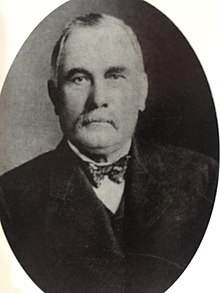Amos Kling
Amos Hall Kling (June 15, 1833 – October 20, 1913) was an American businessman. He was the father-in-law of U.S. President
Amos Kling | |
|---|---|
 | |
| Born | Amos Hall Kling June 15, 1833 Lancaster County, Pennsylvania, U.S.A. |
| Died | October 20, 1913 (aged 80) |
| Spouses |
|
| Children | 3 including, Florence Harding |
| Relatives | Warren G. Harding (son-in-law) Marshall Eugene DeWolfe (grandson) |
Early life
Kling was born on June 15, 1833, in Lancaster County, Pennsylvania, the third of nine children born to Micheal and Elizabeth Kling.[1] His father was of German descent, while his mother was born in France.[2] At a young age, Amos learned the trade of a tailor.[3] The Klings moved to Mansfield, Ohio, and took up farming when Amos was a teenager.[4] Amos graduated from W.W. Granger's commercial college in Mansfield in 1854 and moved to Marion, Ohio, the following year.[5] Kling took a job as a clerk in Bain's Hardware store and soon saved up enough money to buy the store. He met Louisa Bouton during a trip to New Canaan, Connecticut, in the late 1850s.[4] Said to be the most popular girl in town, Kling wed her on September 27, 1859. When the couple returned to Marion, her family came as well and Bouton's father established a shoe company.[6]
Family and business career
His first daughter
Kling became a prosperous businessman from selling real estate, importing horses from France, and other business pursuits. He was on the boards of the Marion Telephone Company, the Marion National Bank, and the
When Kling found out that his daughter was dating a young newspaper publisher named
Kling continued in his disgust for Harding long after the marriage, essentially ending his relationship with Florence. He pressured other Marion businessmen not to invest in any endeavor Harding partook in. He financed the Republican Transcript to compete with Harding's Marion Star. Harding largely avoided the fray, remarking that Kling "knew how to spend money effectively" when Kling ran for city council.[18] Shortly after returning from Florida, Kling's wife died on June 23, 1893, of peritonitis.[19] When Harding ran for state senate in 1899, Kling unsurprisingly opposed him, spreading the black ancestry myth and attempting to get his friend Mark Hanna involved, ultimately to no avail as Harding won the election.[20]
Later life and death
Kling gradually warmed somewhat to his son-in-law, writing him a letter apologizing for past malice and inviting the Harding couple on European vacations. In 1906, Kling remarried a widow 38 years his junior, Caroline Beatty Denman.[21] In 1907, Kling had a summer home built in Daytona Beach, Florida.[22] He suffered from kidney disease in his later years and became bedridden after an attack in spring 1913. Florence was having her own kidney troubles at the time so Harding visited the old man, who was optimistic about recovery. On October 20, 1913, Kling died.[23] Despite their strained relationship, his daughter received $35,000 and valuable real estate in the will, as well as managing a trust fund for Vetallis. He additionally granted $25,000 to his three grandchildren apiece, $5,000 to brothers George and Donald, and donated $10,000 to the Ladies' Home Association. Since he still counseled Warren against engaging in politics, Kling's death ultimately paved the way for Harding's political rise, first to U.S. Senator and eventually President.[24]
References
- ^ ISBN 0688077943.
- ^ Anthony 1998, pp. 6-7
- ^ a b Leggett, Conaway (1883). The History of Marion County, Ohio. Chicago: Warner, Beers & Co. p. 600.
- ^ ISBN 978-0-7006-1649-7.
- ^ a b Anthony 1998, p. 4
- ^ Sibley 2009, p. 11
- ^ Anthony 1998, pp. 10-11
- ^ Sibley 2009, p. 12.
- ^ Anthony 1998, p. 9
- ISBN 0-8050-6956-9.
- ^ Anthony 1998, p. 12
- ^ Sibley 2009, pp. 13-14
- ^ Anthony 1998, pp. 32-33
- ^ Dean 2004 pp. 18-19
- ^ Dean 2004. p. 20
- ISBN 978-1625849427.
- ^ Anthony 1998, pp. 38-43
- ^ Anthony 1998, p. 57
- ^ Anthony 1998, p. 58
- ^ Anthony 1998, pp. 72-73
- ^ Anthony 1998, p. 84
- Daytona Beach News-Journal. Retrieved December 31, 2019.
- ^ Anthony 1998, p. 107
- ^ Anthony 1998, pp. 108-109
